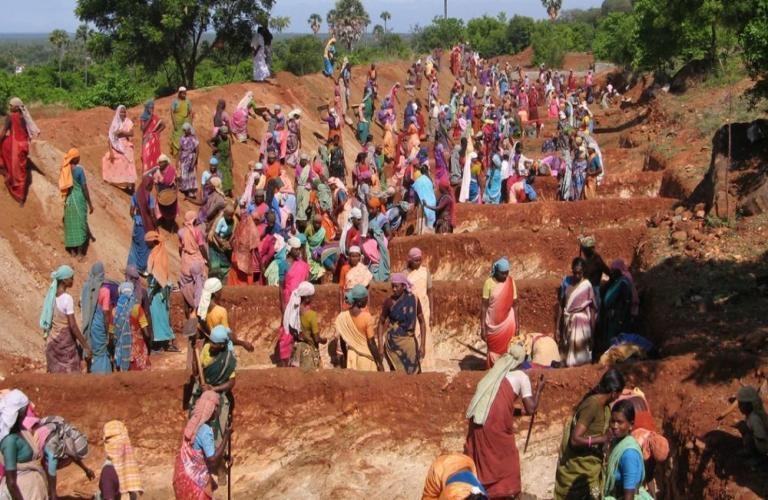Rural Distress: 9 Crore Applied For MGNREGS Work Last Year

Image Courtesy: Rural Marketing
Nearly 9 crore Indians applied for work in the rural jobs guarantee scheme (MGNREGS) in 2017-18, according to data put out by the ministry of rural development. That’s a staggering 42% of the rural work force. Of those who applied for work, some 1.4 crore persons (or about 15%) were turned back with 7.6 crore actually getting work.
In the Modi era, which started in 2014, work seekers in MGNREGS has risen dramatically from about 7.3 crore in 2014 to nearly 9 crore in 2017-18 – a jump of nearly 23%.
Work under the rural jobs scheme is poorly paid, irregular, casual labour. It is mostly hard manual work in civil works like making roads, digging ponds and so on. Yet people in rural India are flocking to seek it in ever increasing numbers. Coming as this does in a second successive good monsoon year, and with overall agricultural output at near record levels, the massive surge of work seekers shockingly reveals the dire job crisis facing India’s rural areas.
While the Prime Minister and his colleagues in the govt. have been assuring people that farmers’ incomes will double by 2022, that 1 crore jobs will be created every year and that farmers will get produce prices that are 50% more than their production cost, these work-seekers’ figures starkly show that none of these promises has been fulfilled.
Recently, on 31 March, the ministry ‘revised’ the wage-rates to be effective from 1 April under the scheme in different states. The average daily wage works out to just Rs.182.9. In 2017-18, on an average, people got just 46 days of work in the scheme. This is the slender thread by which 7.6 crore people hung on and survived last year.
Except two, all other states’ wage rates under MGNREGS are less than the statutory minimum wage for agricultural workers in the state. The two states with MGNREGS wages higher than the state’s minimum wage are Maharashtra and Tamil Nadu where the daily minimum wage rate is already very low, at Rs.194 in Maharashtra and Rs.195 in Tamil Nadu.
In at least 10 states, including many of the BJP ruled states like Bihar, Uttarakhand, Jharkhand, there is no revision of the MGNREGS wage – it will continue to be the same as last year. Some other BJP ruled states like Gujarat, Maharashtra and Madhya Pradesh wages have been increased by just Rs.2 per day!
According to data put out by the rural development ministry, in 2017-18 just 46 days of work was made available under the scheme, although the Act that governs the scheme says that 100 days of work has to be provided. In previous years too the average was of this order.
Seen in this background, it is remarkable that the demand for work – even at an average of Rs.183 per day, and for just 46 days a year – is unflagging. There could be no better proof of the utter failure of the govt. to address the agrarian crisis of no work-low wages-low harvest prices that repeatedly leads to outbursts of anger in the form of farmers’ protests or increasing farmers’ suicides.
In reality, most people in rural areas are working for short periods at different jobs. In harvesting season they may do harvesting and related jobs, either near their home or in distant states where they migrate for work. They may work at construction projects, or salt pans, or brick kilns or other such back-breaking jobs for a few months. They migrate to nearby towns and cities to ply cycle rickshaws, work as domestic servants or do other odd jobs. And, when work becomes available under MGNREGS in their area they work in it for two or three weeks.
The govt. which was very hostile to the scheme initially and slashed funds in 2014-15, realized that it was politically impossible to do so and has since become a great supporter of the scheme. Only recently, the ministry patted itself on the back saying that it had increased funding to the scheme by as much as 37% compared to 2013-14. Ignoring for the moment that this increase in 2017-18 was mainly to compensate for expenses already incurred in the previous year, the govt.’s applauding of the scheme is also an indictment of its utter failure to address the twin crises confronting India today – joblessness and shrinking agrarian incomes.
Get the latest reports & analysis with people's perspective on Protests, movements & deep analytical videos, discussions of the current affairs in your Telegram app. Subscribe to NewsClick's Telegram channel & get Real-Time updates on stories, as they get published on our website.























